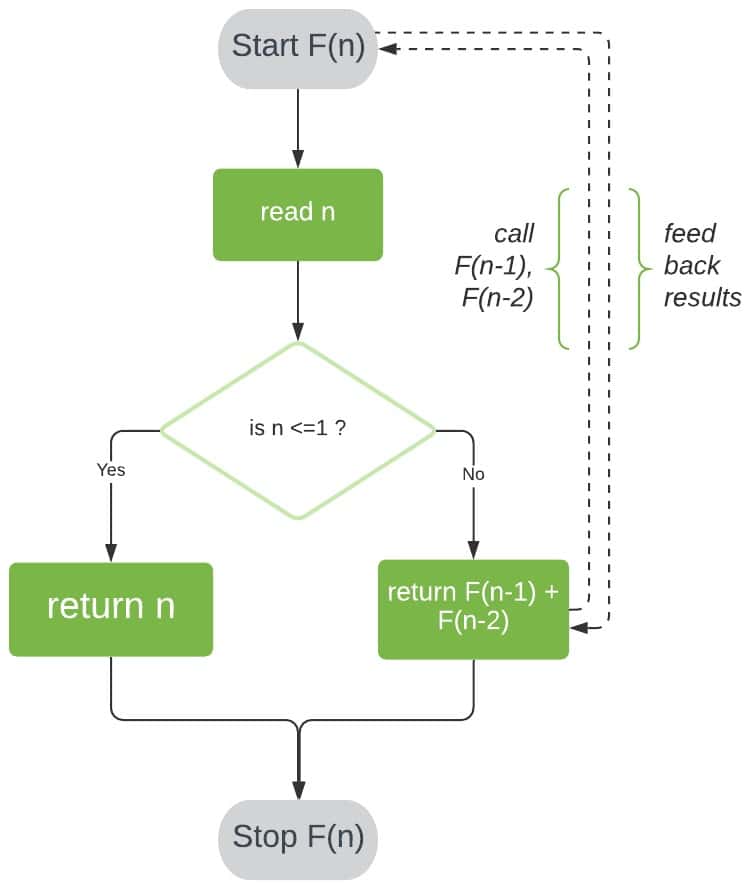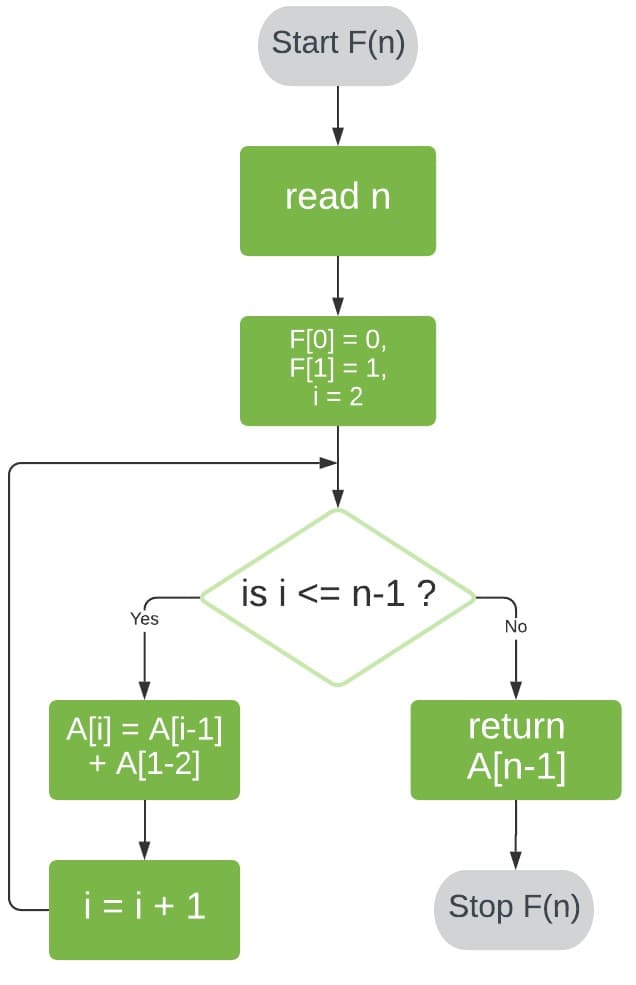1. 概述
在本文中,我们将实现两个常见的用于计算斐波那契数列第 n 项的算法,并分析它们的时间复杂度。通过这个过程,我们可以对比不同算法在性能上的差异。
2. 斐波那契数列简介
斐波那契数列是一个从 0 和 1 开始的无限正整数序列,后续每一项等于前两项之和。
我们用 Fn 表示数列中第 n 项,其定义如下:
- F₀ = 0
- F₁ = 1
- Fₙ = Fₙ₋₁ + Fₙ₋₂ (当 n > 1)
因此,数列的起始部分如下:
0, 1, 1, 2, 3, 5, 8, 13, ...
现在的问题是,如何设计一个算法,返回该数列中第 n 项的值?
3. 递归算法
我们先从最直观的方式入手:使用递归实现斐波那契数列的计算。
3.1 实现思路
我们定义一个函数 *F(n)*,用于返回 Fₙ 的值。根据定义:
- 如果 n ≤ 1,直接返回 n;
- 否则,递归调用 F(n-1) 和 *F(n-2)*,并返回它们的和。
这个方法虽然逻辑清晰,但存在明显的重复计算问题。
下图展示了递归调用树的结构:

3.2 Java 伪代码实现
algorithm F(n):
// INPUT
// n = Some non-negative integer
// OUTPUT
// The nth number in the Fibonacci Sequence
if n <= 1:
return n
else:
return F(n - 1) + F(n - 2)
4. 时间复杂度分析
为了评估该算法的效率,我们需要分析其时间复杂度。
4.1 时间复杂度建模
设 T(n) 表示计算 F(n) 所需的加法次数。由于递归调用 F(n-1) 和 *F(n-2)*,我们可以建立如下递推式:
- T(n) = T(n-1) + T(n-2) + 1 (n > 1)
- T(0) = T(1) = 0
4.2 简化递推式
为简化分析,我们假设 *T(n-2) ≈ T(n-1)*,则:
T(n) ≈ 2 * T(n-1) + 1
这将递推式简化为一个更容易求解的形式。
4.3 使用后向代入求解
通过逐步代入,我们得到:
T(n) = 2^k * T(n-k) + (2^k - 1)
当 k = n 时,T(n-k) = T(0) = 0,最终得到:
T(n) = O(2^n)
4.4 分析结果
虽然我们做了一些近似处理,但可以确定的是,该递归算法的时间复杂度是指数级的,即 **O(2ⁿ)**。
更精确的上界为 **O(Φⁿ)**,其中 Φ 是黄金分割比((1 + √5)/2)。
✅ 结论:递归算法效率非常低,存在大量重复计算。
5. 迭代算法
接下来,我们介绍一种更高效的实现方式:迭代法。
5.1 实现思路
我们从已知的初始值 F₀ = 0 和 F₁ = 1 开始,依次计算后续每一项,直到第 n 项。
具体步骤如下:
- 初始化数组 F[0] = 0, F[1] = 1
- 从索引 2 开始遍历到 n-1
- 每次计算 F[i] = F[i-1] + F[i-2]
下图展示了迭代过程:

5.2 Java 伪代码实现
algorithm F(n):
// INPUT
// n = Some non-negative integer
// OUTPUT
// The nth number in the Fibonacci Sequence
A[0] <- 0
A[1] <- 1
for i <- 2 to n - 1:
A[i] <- A[i - 1] + A[i - 2]
return A[n - 1]
5.3 时间复杂度分析
该算法的时间复杂度分析非常直观:
- 初始化两个值:O(1)
- 循环执行 n-2 次:O(n)
因此,总时间复杂度为 **O(n)**。
✅ 结论:迭代算法的时间复杂度显著优于递归实现。
6. 总结
本文我们分析了两种常见的斐波那契数列计算方法:
- ✅ 递归算法:时间复杂度为 **O(2ⁿ)**,效率低,存在大量重复计算;
- ✅ 迭代算法:时间复杂度为 **O(n)**,性能更好,适合实际应用;
📌 建议:在实际开发中尽量避免使用原始递归方式计算斐波那契数列,可考虑使用迭代、记忆化递归或矩阵快速幂等优化方法。